Windows Mobile
Windows Mobile 6.5.3 Today Screen |
|
| Company / developer | Microsoft |
| Programmed in | C++[1] |
| OS family | Windows CE |
| Working state | Current |
| Initial release | 19 April 2000 |
| Latest stable release | 6.5.3 / 2 February 2010 |
| Latest unstable release | 6.5.5 |
| Marketing target | Mobile devices |
| Kernel type | Windows CE 5.2 (released in 2004) |
| Default user interface | Graphical |
| License | Proprietary (Microsoft EULA) |
| Official website | Windows Mobile |
Windows Mobile (rebranded as Windows Phone with the launch of Windows Phone 7) is a mobile operating system developed by Microsoft for use in smartphones and mobile devices.
The current version is called "Windows Mobile 6.5". It is based on the Windows CE 5.2 kernel, and features a suite of basic applications developed using the Microsoft Windows API. It is designed to be somewhat similar to desktop versions of Windows, feature-wise and aesthetically. Additionally, third-party software development is available for Windows Mobile, and software can be purchased via the Windows Marketplace for Mobile.
Originally appearing as the Pocket PC 2000 operating system, most Windows Mobile devices come with a stylus pen, which is used to enter commands by tapping it on the screen.[2] Microsoft announced a completely new phone platform, Windows Phone 7, at the Mobile World Congress in Barcelona on February 15, 2010. Phones running Windows Mobile 6.x will not be upgradeable to version 7.[3]
Windows Mobile's share of the Smartphone market has fallen year-on-year,[4] decreasing 20% in Q3 2009.[5] It is the 5th most popular smartphone operating system, with a 5% share of the worldwide smartphone market (after Symbian, BlackBerry OS, Android and iPhone).[6] In the United States, it is the 3rd most popular smartphone operating system for business use (after BlackBerry OS and iPhone), with a 24% share among enterprise users.[7]
Contents |
Common features
Windows Mobile for Pocket PC carries these standard features in most of its versions:
- Today Screen shows the current date, owner information, upcoming appointments, e-mail messages, and tasks. (Is now Home screen in later WM6.5 builds)
- The taskbar shows the current time and the volume.
- Office Mobile a suite of Mobile versions of Microsoft Office applications
- Outlook Mobile comes with Windows Mobile.
- Internet Explorer Mobile is an Internet browser developed by Microsoft for Pocket PC and Handheld PC that comes loaded by default with Windows Mobile and Windows CE for Handheld PC.
- Windows Media Player for Windows Mobile.
- Client for PPTP VPNs.
- Internet Connection Sharing (ICS) which in mobile phones allows attached computers to share internet connections via USB and Bluetooth.
- Coherent file system similar to that of Windows 9x/Windows NT and support for many of the same file types.
- Ability to multitask.
Hardware
There are three versions of Windows Mobile for various hardware devices:[8]
- Windows Mobile Professional runs on 'Windows Phones' (smartphones) with touchscreens
- Windows Mobile Standard runs on 'Windows Phones' with regular screens
- Windows Mobile Classic which runs on 'Windows Mobile Classic devices' (Pocket PCs).
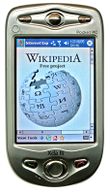
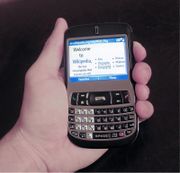
Windows Mobile Classic devices (Pocket PC)
A 'Windows Mobile Classic device' is a Windows Mobile personal digital assistant (PDA) that does not have telephone functionality. It was formerly known as the Pocket PC. It was the original intended platform for the Windows Mobile operating system. These devices consisted of both standalone Pocket PC devices without mobile phone capabilities, and those that included mobile phone capabilities. The most current name of Windows Mobile intended for use on Pocket PCs is officially "Windows Mobile 6 Professional" for devices with mobile phone capabilities and "Windows Mobile 6 Classic" for devices without mobile phone capabilities.
Windows Phone
The 'Windows Mobile' (Microsoft's term for its range of smartphones) became the next hardware platform after the Pocket PC to run Windows Mobile, and debuted with the release of Pocket PC 2002. Although in the broad sense of the term "Smartphone", both Pocket PC phones and Microsoft branded Smartphones each fit into this category, it should be noted that Microsoft's use of the term "Smartphone" includes only more specific hardware devices that differ from Pocket PC phones. Such Smartphones were originally designed without touchscreens, intended to be operated more efficiently with only one hand, and typically had lower display resolution than Pocket PCs. Microsoft's focus for the Smartphone platform was to create a device that functioned well as a phone and data device in a more integrated manner.[9]
Versions
Pocket PC 2000
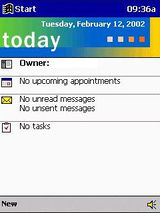
Pocket PC 2000, originally codenamed "Rapier",[10] was released on April 19, 2000, and was based on Windows CE 3.0. It was the debut of what was later dubbed the Windows Mobile operating system, and meant to be a successor to the operating system aboard Palm-Size PCs. Backwards compatibility was retained with such Palm-Size PC applications. Pocket PC 2000 was intended mainly for Pocket PC devices, however several Palm-Size PC devices had the ability to be updated as well. In addition, several Pocket PC 2000 phones were released, however Microsoft's "Smartphone" hardware platform was not yet created. The only resolution supported by this release was 240 x 320 (QVGA). Removable storage card formats that were supported were CompactFlash and MultiMediaCard. At this time Pocket PC devices had not been standardized with a specific CPU architecture. As a result, Pocket PC 2000 was released on multiple CPU architectures; SH-3, MIPS, and ARM.
Aesthetically, the original Pocket PC operating system was similar to Windows 98, Windows Me, and Windows 2000 operating systems.
Features/built-in applications for Pocket PC 2000 included the following:[11]
- Pocket Office
- Pocket Word
- Pocket Excel
- Pocket Outlook
- Pocket Internet Explorer
- Windows Media Player
- Microsoft Reader
- Microsoft Money
- Notes, a note taking application
- Character recognition support
- Infrared (IR) File beaming capability
Pocket PC 2002
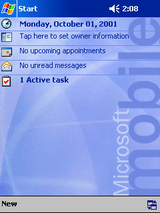
Pocket PC 2002, originally codenamed "Merlin",[10] was released in October 2001. Like Pocket PC 2000, it was powered by Windows CE 3.0. Although targeted mainly for 240 × 320 (QVGA) Pocket PC devices, Pocket PC 2002 was also used for Pocket PC phones, and for the first time, Smartphones.[12] These Pocket PC 2002 Smartphones were mainly GSM devices. With future releases, the Pocket PC and Smartphone lines would increasingly collide as the licensing terms were relaxed allowing OEMs to take advantage of more innovative, individual design ideas. Aesthetically, Pocket PC 2002 was meant to be similar in design to the then newly released Windows XP.
New features/built-in applications included the following:[13][14][15][16]
- Enhanced UI with theme support
- Spell checker and Word count tool in Pocket Word
- Savable downloads and WAP in Pocket Internet Explorer
- Virtual Private Networking support
- Synchronization of folders
- MSN Messenger
- Terminal Services
- Windows Media Player 8 with streaming capability
- Microsoft Reader 2
- Palm OS support for file beaming
- Improved Pocket Outlook
- Digital rights management (DRM) support in Microsoft Reader
Windows Mobile 2003
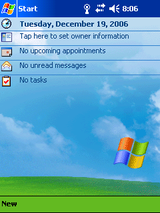
Windows Mobile 2003, originally codenamed "Ozone",[10] was released on June 23, 2003, and was the first release under the Windows Mobile banner. It came in four editions: "Windows Mobile 2003 for Pocket PC Premium Edition", "Windows Mobile 2003 for Pocket PC Professional Edition", "Windows Mobile 2003 for Smartphone" and "Windows Mobile 2003 for Pocket PC Phone Edition". The last was designed especially for Pocket PCs which include phone functionalities. The Professional Edition was used in Pocket PC budget models. It lacked a number of features that were in the Premium Edition, such as a client for L2TP/IPsec VPNs. Windows Mobile 2003 was powered by Windows CE 4.20.
New features/built-in applications included the following:[17]
- Support for add-on keyboards
- Enhanced communications interface with Bluetooth device management
- Bluetooth file beaming support
- Bluetooth headset support
- Pictures application with viewing, cropping, e-mail, and beaming support
- Jawbreaker game
- Enhanced Pocket Outlook with vCard and vCal support
- Improved Pocket Internet Explorer
- Windows Media Player 9.0 with streaming optimization
- SMS reply options for Phone Edition
- MIDI file support as ringtones in Phone Edition
Windows Mobile 2003 SE
Windows Mobile 2003 Second Edition, also known as "Windows Mobile 2003 SE", was released on March 24, 2004 and first offered on the Dell Axim x30. This was the last version which allowed users to backup and restore an entire device through ActiveSync.
New features/built-in applications included the following:
- Portrait and Landscape switching for Pocket PCs
- Single-Column layout in Pocket Internet Explorer
- VGA (640×480), 176х220, 240x240, 480x480 Screen resolution
- Wi-Fi Protected Access (WPA) support
Windows Mobile 5

Windows Mobile 5.0, originally codenamed "Magneto",[10] was released at Microsoft's Mobile and Embedded Developers Conference 2005 in Las Vegas, May 9–May 12, 2005. Microsoft plans to offer mainstream support for Windows Mobile 5 through October 12, 2010, and extended support through October 13, 2015.[18] It was first offered on the Dell Axim x51. It used the .NET Compact Framework 1.0 SP3 — an environment for programs based on .NET.
- Windows Mobile 5.0 included Microsoft Exchange Server "push" functionality improvements that worked with Exchange 2003 SP2.[19] The "push" functionality also required vendor/device support[20] With AKU2 software upgrades all WM 5.0 devices supported DirectPush.
- WM 5.0 featured increased battery life due to Persistent storage capability. Previously up to 50% (enough for 72 hours of storage) of battery power was reserved just to maintain data in volatile RAM. This continued the trend of Windows-based devices moving from using RAM as their primary storage medium to the use of a combination of RAM and flash memory (in use, there's no distinction between the two apparent to the user). Programs and frequently accessed data run in RAM, while most storage is in the flash memory. The OS seamlessly moves data between the two as needed. Everything is backed up in the flash memory, so unlike previous devices, WM5 devices do not lose any data if power is lost.
- With Windows Mobile 5.0, OS updates were released as Adaptation kit upgrades. AKU 3.5 is the most recent release for WM 5.0.
Further new features and built-in applications included:
- New version of Office called "Office Mobile"
- PowerPoint Mobile
- Graphing capability in Excel Mobile
- Tables and graphics insertion in Word Mobile
- Windows Media Player 10 Mobile
- Photo Caller ID
- DirectShow support
- Picture and Video package, which converged the management of videos and pictures
- Enhanced Bluetooth support
- Global Positioning System (GPS) management interface
- Default QWERTY keyboard-support
- Error reporting facility similar to that present in desktop and server Windows systems
- ActiveSync 4.2 with 15% increased synchronization speed
Windows Mobile 6
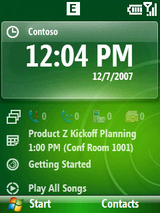
Windows Mobile 6, formerly codenamed "Crossbow",[10] was released on February 12, 2007[21] at the 3GSM World Congress 2007. It comes in three different versions: "Windows Mobile 6 Standard" for Smartphones (phones without touchscreens), "Windows Mobile 6 Professional" for Pocket PCs with phone functionality, and "Windows Mobile 6 Classic" for Pocket PCs without cellular radios.[22]
Windows Mobile 6 is powered by Windows CE 5.0 (version 5.2) and is strongly linked to Windows Live and Exchange 2007 products. Windows Mobile 6 Standard was first offered on the Orange's SPV E650,[23] while Windows Mobile 6 Professional was first offered on the O2's Xda Terra.[24] Aesthetically, Windows Mobile 6 was meant to be similar in design to the then newly released Windows Vista. Functionally, it works much like Windows Mobile 5, but with much better stability.
New features/built-in applications include the following:[25]
- 320x320 and 800x480 (WVGA) screen resolution support (The S01SH or "Em One" by Sharp was the first and only device to have a 800x480 screen on WM5)[26]
- Office Mobile support for Smartphones
- Operating System Live Update[27]
- Improved Remote Desktop access[28] (Available for only certain Pocket PCs)[29]
- VoIP (Internet calling) support with AEC (Acoustic Echo Cancelling) and MSRT Audio Codec
- Windows Live for Windows Mobile[30]
- Customer Feedback option[31]
- Enhanced Microsoft Bluetooth Stack
- Storage Card Encryption (encryption keys are lost if device is cold-booted).
- Smartfilter for searching within programs
- Improved Internet Sharing
- HTML email support in Outlook Mobile
- Search ability for contacts in an Exchange Server Address Book
- AJAX, JavaScript, and XMLDOM support on Internet Explorer Mobile
- Out of Office Replies with Microsoft Exchange 2007
- Unlicensed Mobile Access (UMA) support for select operators
- Server Search on Microsoft Exchange 2007
- .NET Compact Framework v2 SP2 Preinstalled in ROM
- Microsoft SQL Server 2005 Compact Edition Preinstalled in ROM
- OneNote Mobile as a companion to Microsoft Office OneNote
- Office Mobile 6.1 announced[32] with support for Office 2007 document formats (pptx, docx, xlsx).
Windows Mobile 6.1
.png)
Windows Mobile 6.1 was announced April 1, 2008. It is a minor upgrade to the existing Windows Mobile 6 platform which brings with it various performance enhancements, a redesigned Home screen featuring horizontal tiles that expand on clicking to display more information, although this new home screen is featured only on Windows Mobile Standard edition. This feature was inexplicably left out of the Professional edition.[33] Several other changes such as threaded SMS, full page zooming in Internet Explorer and 'Domain Enroll' have also been added, along with a "mobile" version of the Microsoft OneNote program and an interactive "Getting Started" wizard. Domain Enroll is functionality to connect the device to System Center Mobile Device Manager 2008, a product to manage mobile devices.[34] There are other differences as well. The most prominent difference for the user is that the Standard version (like earlier versions) still creates automatic links for telephone numbers in Tasks and Appointments, which allows for the easier click and dial of stored telephone numbers within these Outlook items. For some reason, the Professional version has eliminated this important feature. Windows Mobile 6.1 also featured improved bandwidth efficiency in its push-email protocol "Activesync" of "up to 40%",[35] this reduced data usage was the cause of considerably improved battery life in many devices.
Aside from the visual and feature distinctions, the underlying CE versions can be used to differentiate WM6.0 from WM 6.1. The version of Windows CE in WM 6.0 is 5.2.*, with the final number being a 4 digit build ID (e.g. 5.2.1622 on HTC Wing). In WM 6.1, the CE version is 5.2.* with a 5 digit build number (e.g. 5.2.19216 on Palm Treo 800w).
Windows Mobile 6.5
Windows Mobile 6.5 was never part of Microsoft's mobile phone roadmap, and has been described by its chief executive, Steve Ballmer, as "not the full release [Microsoft] wanted" until the multi-touch enabled Windows Mobile 7 (now replaced by Windows Phone 7) arrives in 2010.[36] Version 6.5 is an upgrade to Windows Mobile 6.1 that was released to manufacturers on May 11, 2009, and the first devices running the operating system debuted in late October '09.[37] This incremental update includes some significant new added features, such as a revamped GUI, new today screen with vertically scrollable labels (called 'Titanium'); though is generally regarded as a minor upgrade.[38] It also includes the new Internet Explorer Mobile 6 browser, which has an improved interface over previous versions.[39]
Microsoft unveiled this version at the 2009 Mobile World Congress in February,[40] and several devices now run this Windows Mobile version,[41] those devices running Windows Mobile 6.5 onwards are marketed as "Windows phones". Along with Windows Mobile 6.5, Microsoft announced several Cloud computing services codenamed "SkyBox","SkyLine","SkyMarket".[42] "SkyBox" has been confirmed as My Phone,[43] while "SkyMarket" has been confirmed as Windows Marketplace for Mobile.[44] Some aspects of the user interface have been redesigned with the home screen resembling that of Microsoft's Zune player and the sliding panel interface of Windows Mobile 6.1 Standard. This version was designed mainly for easier finger usage.[45] Whilst this version of Windows Mobile does not natively support capacitive screens, mobile manufacturers have been able to successfully implement it on their devices [46]
Several phones currently running Windows Mobile 6.1 are updatable to Windows Mobile 6.5.[47]
Windows Mobile 6.5.1
Builds of Windows Mobile 6.5.1 have been unofficially ported to several Windows Mobile phones.[48] Windows Mobile 6.5.1 brings a more finger-friendly user interface,[49] including icon based soft buttons (rather than text based),[50] an updated contacts app,[51] Microsoft (rather than the mobile carrier) support for A-GPS,[49] improved threaded text messaging,[52] and performance improvements.[53]
Windows Mobile 6.5.3
On February 2, 2010, the Sony Ericsson Aspen with Windows Mobile 6.5.3 was officially announced, making it the first Windows Phone 6.5.3 smartphone.[54] Since November 2009, several 6.5.3 builds had leaked (28nnn) and had been unofficially ported to some Windows Mobile phones.
Windows Mobile 6.5.3 brings a more finger-friendly user interface with several new ease of use features such as support for multitouch, complete touch control i.e. no need for a stylus, and drag and drop start menu icons. Touchable tiles now replace soft keys."[55] Internet Explorer Mobile 6 has also received some major updates including decreased page load time, improved memory management and gesture smoothing.[56]
Additional features of newer Windows Mobile 6.5.3 builds include threaded email and Office Mobile 2010.[56]
Windows Mobile 6.5.5
Several builds of Windows Mobile have leaked since January 2010 and have been unofficially ported to some Windows Mobile phones.[57] The name Windows Mobile 6.5.5 has been applied to these newer builds. However, this naming scheme remains unconfirmed by Microsoft.
Future versions
Windows Phone 7
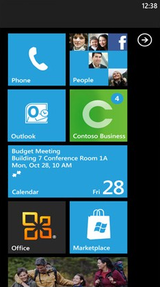
Microsoft had originally planned to continue the Windows Mobile line to Windows Mobile 7, based on an upgrade to the Windows Mobile platform, codenamed Photon. The original Photon and Windows Mobile 7 have since been scrapped, however, Microsoft officially announced Windows Phone 7 Series in its place.[58] Microsoft has since renamed the operating system from Windows Phone 7 Series to Windows Phone 7.[59] It is planned for release by "holiday" 2010.
Windows Phone 7 was initially intended to be released during 2009, but several delays, and likely due to the move away from Photon, prompted Microsoft to develop Windows Mobile 6.5 as an interim release. During the Mobile World Congress 2010 in Barcelona, Microsoft revealed details of Windows Phone 7, which features a new operating system and integration with Xbox Live and Zune services.[60]
Phones currently running Windows Mobile 6.x will not be upgradeable to Windows Phone 7.[61]
Applications built for Windows Mobile 6.x or earlier will not run on Windows Phone 7. The Windows Phone 7 operating system has been rebuilt to only support Silverlight and XNA based applications.
Microsoft Kin
Microsoft Kin evolved from Microsoft's purchase of Danger Hiptop in 2008.[62] Details are scarce, but a ZDNet source said that Microsoft Kin brings an entirely new software stack and services.[63] Some reports say that the new mobile phone platform is based around the Zune media device.[64]
Microsoft Kin was developed inside Microsoft's Premium Mobile Experiences (PMX) division.[65] Microsoft brought in employees from Danger Inc., with the intention of infusing industry talent and mobile experience into the project. The goal was said to be to create a mobile platform far superior to that of the Danger Sidekick. Reports say that Microsoft Kin was originally going to be based on Windows Phone 7. However, due to delays with the latter, it was built directly upon Windows CE. It will feature the Zune marketplace, and uses XNA as a game platform.[65]
The new platform is aimed at producing phones designed for users who are heavily into social networking and instant messaging.[66] The technology acquired from Danger Hiptop has been described as a family of mobile devices running a bespoke operating system as part of a client–server system that is then licenced to mobile carriers.[67]
Microsoft debuted two new handsets based on Microsoft Kin, codenamed Turtle and Pure, possibly to debut at the Consumer Electronics Show.[68] The Microsoft designed phones are manufactured by Sharp and co-branded.[69] According to the MobileTechWorld website, Microsoft Kin is a software service running on top of Windows Phone 7 devices.[70] Microsoft announced the discontinuation of the KIN line on June 30, 2010, only six weeks after it was launched.[71]
Naming conventions
| Pocket PC 2000 | Pocket PC 2002 | Windows Mobile 2003 | Windows Mobile 2003 SE | Windows Mobile 5.0 | Windows Mobile 6 | Windows Mobile 6.1 | Windows Mobile 6.5 | |
|---|---|---|---|---|---|---|---|---|
| Pocket PC (Without Mobile Phone) | Pocket PC 2000 | Pocket PC 2002 | Windows Mobile 2003 for Pocket PC | N/A | Windows Mobile 5.0 for Pocket PC | Windows Mobile 6 Classic | Windows Mobile 6.1 Classic | N/A |
| Pocket PC (With Mobile Phone) | Pocket PC 2000 Phone Edition | Pocket PC 2002 Phone Edition | Windows Mobile 2003 for Pocket PC Phone Edition | Windows Mobile 2003 SE for Pocket PC Phone Edition | Windows Mobile 5.0 for Pocket PC Phone Edition | Windows Mobile 6 Professional | Windows Mobile 6.1 Professional | Windows Mobile 6.5 Professional |
| Smartphone (Without Touch Screen) | N/A | Smartphone 2002 | Windows Mobile 2003 for Smartphone | Windows Mobile 2003 SE for Smartphone | Windows Mobile 5.0 for Smartphone | Windows Mobile 6 Standard | Windows Mobile 6.1 Standard | Windows Mobile 6.5 Standard |
Other: Windows Mobile for Automotive 1.0, Windows Mobile software for Portable Media Centers
History

Windows Mobile's share of the smartphone market has been in decline year-on-year. Gartner research data showed that while the total smartphone industry grew 27% between 2008 and 2009, Windows Phone's share of the smartphone market fell 2.7% in that same period.[4]
In 2004, Windows Mobile accounted for 23% of worldwide smartphone sales.[72] By 2008, its share had dropped to 14%.[73] Microsoft licensed Windows Phone to four out of the world's five largest mobile phone manufacturers, with Nokia being the exception.[74]
Although Microsoft apparently has 50 handset partners,[75] 80% of the 50 million Windows Phone devices made have been built by one contract manufacturing group, HTC, which makes handsets for several major companies under their brands, as well as under its own brand.[76]
In February 2009 Microsoft signed a deal with the third largest mobile phone maker, LG Electronics, to license Windows Mobile OS on 50 upcoming LG smartphone models.[77] But in September, 2009, Palm, Inc. announced it would drop Windows Phone from its smartphone line-up.[78] An October 2009 report in DigiTimes said that Acer will shift its focus from Windows Phone to Google Android.[79]
Windows Mobile used to be the most popular handset for business use, but 2009 saw this position depreciate. An InformationWeek survey found that 24% of planned business deployments of mobile application were for Windows Phone, putting it in 3rd place, behind Blackberry (61%) and iPhone (27%).[7]
In October, 2009, Gartner predicted that by 2012, Windows Phone will remain the 4th most popular smartphone platform during the rise of Android only due to BlackBerry falling from 2nd to 5th.[80] The New York Times said that cellular telephone manufacturers are moving away from Windows Phone, and instead shifting towards Android.[81] Taiwan's Intelligence & Consulting Institute (MIC) predicted that Android's popularity may force Microsoft to reduce the Windows Phone licensing fees it charges handset makers, in order to reduce further market share losses.[82]
Windows Phone's loss of market share became more rapid in Q3 2009. It suffered a 20% drop in Q3 compared to the previous quarter, at a time when total smartphone sales with all operating systems rose 13%. Gartner estimated that in Q3, 2009, Windows Phone share of worldwide smartphone sales was 7.9%.[5]
Samsung announced in November 2009 that it will phase out the Windows Phone platform,[83] to concentrate on its own bada operating system, as well as Google's Android.[84]
Possible trends
In late 2009, many industry analysts and media reports began to express concerns about the future viability of the Windows Mobile platform, and whether Microsoft will keep supporting it into the future.
ZDnet said that "for all practical purposes, Windows Mobile is a dead platform",[85] while CNET said "Windows Mobile has now been relegated resolutely to has-been status."[86]
ABI Research said: "Heading into 2010, the momentum (for Windows Mobile) has dissipated and there has been wide speculation that Microsoft might be ready to bail out on the mobile operating system market altogether."[87]
Gartner analysts questioned whether Windows Mobile had a future beyond version 7, due to its poor performance and falling market share. However, Gartner said that while Windows Mobile may be discontinued for consumer-focused smartphones, it still had a future in specialized industrial applications, such as for ruggedized devices used in warehousing and delivery trucks.[87] Gartner said that Windows Mobile 7 could be "the last throw of the dice."[88]
Analysts J.Gold Associates said in BusinessWeek that Microsoft will likely exit the mobile operating system market sometime between 2010 and 2011, saying "There are better ways for Microsoft to make money from smartphones than to keep investing in a mobile operating system that's losing share and relevance"[89]
The New York Times reported that Windows Mobile "is foundering", as cellphone makers desert it in favor of Google's Android phone platform.[81] It cited the difficulties in Microsoft's business model, which involves charging handset manufacturers up to $25 for each copy of Windows Mobile, while rival Google gives away Android for free.[90]
The Washington Post said Windows Mobile is "bleeding market share in the space, and the future looks grim." It said that Google is using Android to "kill" Windows Mobile.[91]
In February 2010 Microsoft announced a new operating system: Windows Phone 7. It has been built from scratch and bears no resemblance to its predecessors. It is set for release in 'holiday season' 2010.
Software development
Third-party software development is available for the Windows Phone operating system. There are several options for developers to use when deploying a mobile application. This includes writing native code with Visual C++, writing Managed code that works with the .NET Compact Framework, or Server-side code that can be deployed using Internet Explorer Mobile or a mobile client on the user's device. The .NET Compact Framework is actually a subset of the .NET Framework and hence shares many components with software development on desktop clients, application servers, and web servers which have the .NET Framework installed, thus integrating networked computing space (a.k.a. "The Cloud").[92]
Microsoft typically releases Windows Phone Software Development Kits (SDKs) that work in conjunction with their Visual Studio development environment. These SDKs include emulator images for developers to test and debug their applications while writing them. Microsoft also distributes Visual Studio 2008 / 2005 Professional Editions, and server / database counterparts to students as downloads free of charge via its DreamSpark program.[93]
Developer communities have used the SDK to port later versions of Windows Phone OS to older devices and making the OS images available for free, thus providing the devices with the current feature set. Microsoft has tolerated this procedure for some time but decided in February 2007 to ask developers to take their OS images off the net, which in turn raised discussions.[94] At the same time Microsoft offered upgrades to Windows Mobile 6 versions to manufacturers for free.[95]
Lazarus, Lexico, NS Basic and Basic4ppc provide an alternative development environment; they allow for development on the desktop, which is then downloaded to the device. NS Basic and Basic4ppc[96] allow for development on the actual device itself.
Some 3rd party development tools such as Basic4ppc use the .NET Compact Framework. This has been possible only for the last couple years. Prior to the release of Windows Mobile 2003, third-party software was developed using Microsoft's eMbedded Visual Tools, eMbedded Visual Basic (eVB) and eMbedded Visual C (eVC).[97] eVB programs can usually be converted fairly easily to NS Basic/CE.[98] or to Basic4ppc.
There is also a Python port named PythonCE and a GCC port, CeGCC.
Satellite Forms is a RAD tool that can produce Windows Phone compatible applications that use an RDK runtime engine. Extension libraries extend the functionality for various hardware.
On 5 July 2009, Microsoft opened a third-party application distribution service called Windows Marketplace for Mobile.[99]
Criticism
- Versions of Windows Mobile prior to 6.5.3 did not recognize multi-touch screens. Device maker HTC Corporation created some work-arounds to allow multi-touch to work on some applications it installed on its HD2 handset. However, Microsoft applications on this handset, such as the Internet Explorer web browser, do not support multi-touch.[100]
- Windows Mobile does not allow users to view file properties from File Explorer and so it is impossible to remove the "read-only" or "Hidden File" attributes applied to files, although third-party software is available to do this. Hidden files can be viewed.
- Windows Mobile does not allow users to view file extensions of unknown file types, although third-party software is available to do this.
- Windows Mobile devices can easily be used and reset by unauthorised users, such as thieves, as the "Clear Storage" command can be invoked without the need for a password so long as the keypad is not locked and the phone is not turned off, because the CLEAR STORAGE is applied by using embedded, unmodifiable key sequence of "1234" which is also visibly shown in the phone.
- The interface of Windows Mobile 6.5 shows jarring inconsistencies, with some applications requiring the user to hold a Stylus to make them operate.[101]
- Many Windows Phone business applications were designed for a stylus-pen input, and are difficult or impossible to use on a capacitative multi-touch screen.[102]
- Unlike Windows for desktop computers, the Windows Phone operating system cannot be upgraded by the user. Upgrades can only be supplied by telephone service providers or hardware providers. As this requires considerable resource to produce a custom upgrade for each device, generates no income (upgrades have not been chargeable), and extends the life of older equipment instead of encouraging purchase of new, Windows Mobile upgrades are rarely released.[103] However, expert users have developed unofficial, sometimes modified, firmware; this unofficial firmware, or newer Windows Mobile or Phone firmware intended for other devices with the risk of possible incompatibility, can be installed if available with flashing software.
- Several analysts from both Gartner and J.Gold Associates have expressed concern about the long-term future of Windows Phone.[104] Motorola and Fedex said that Microsoft had given a commitment to continue supporting Windows Phone OS, at least for use in rugged industrial devices.[105]
- On 25 September 2009, Microsoft CEO Steve Ballmer indicated that the company "screwed up with Windows Mobile". He lamented that Windows Mobile version 7 was not yet available. He said he had recently changed the Windows Mobile team to try to recoup losses.[106]
- The kernel of Windows Mobile has not been updated for over 6 years. As of January 2010[update] Windows Phone 6.5.x was based on the Windows CE 5.2 kernel, the same kernel that was running in Windows Mobile 5.0 in 2004. The Windows Phone OS has not been optimized for more modern processors, such as the Snapdragon processors.[102]
- A 2009 survey by CFI Group showed that Windows Phone users had a low level of customer satisfaction when compared to users of other smartphones. Out of a possible 100 points, Windows Phone rated only 66, compared with BlackBerry (73), Palm Pre (77), Google Android (77), and iPhone (83).[107]
See also
- ActiveSync
- Adaptation kit upgrade
- Handheld PC
- List of Windows Mobile devices
- Windows Phone 7
- Microsoft data loss 2009
- Microsoft Office Mobile
- Windows Mobile Device Center
- Radio Interface Layer
References
- ↑ Lextrait, Vincent (February 2010). "The Programming Languages Beacon, v10.0". http://www.lextrait.com/Vincent/implementations.html. Retrieved 12 February 2010.
- ↑ Charles Arthur (20 October 2009). "Windows Mobile: where's the love? And where's the sales figure?". The Guardian (London). http://www.guardian.co.uk/technology/blog/2009/oct/20/windows-mobile-reviews-negative.
- ↑ "Microsoft: “No Windows Phone 7 upgrade for Windows Mobile 6.x devices”". APC Magazine. 1 March 2009. http://apcmag.com/microsoft-no-windows-phone-7-upgrade-for-windows-mobile-6x-devices.htm.
- ↑ 4.0 4.1 "Windows Mobile loses 2.7% of smartphone market in Q209". Ars Technica. 12 August 2009. http://arstechnica.com/microsoft/news/2009/08/windows-mobile-loses-27-of-smartphone-market-in-q2.ars. Retrieved 20 September 2009.
- ↑ 5.0 5.1 "Windows Mobile smartphone sales plunge 20% in Q3". ComputerWorld. 12 November 2009. http://www.computerworld.com/s/article/9140761/Windows_Mobile_smartphone_sales_plunge_20_in_Q3.
- ↑ "Gartner: Android has overtaken iPhone worldwide". Electronista. 12 August 2010. http://www.electronista.com/articles/10/08/12/analysts.say.android.passing.ios.near.blackberry/.
- ↑ 7.0 7.1 "Air Pressure: Why IT Must Sort Out App Mobilization Challenges". InformationWeek. 5 December 2009. http://www.informationweek.com/news/mobility/business/showArticle.jhtml?articleID=222000504.
- ↑ "Windows Mobile Editions Get Less Confusing Names: Professional, Standard and Classic". Gizmodo. 29 January 2007. http://gizmodo.com/232300/windows-mobile-editions-get-less-confusing-names-professional-standard-and-classic. Retrieved 4 October 2009.
- ↑ Mobile Phones|Smartphone - Software Features Overview. Microsoft. Retrieved 6 September 2007 from the Internet Archive.
- ↑ 10.0 10.1 10.2 10.3 10.4 De Herrera, Chris. Windows CE/Windows Mobile Versions. pocketpcfaq.com. Retrieved 6 September 2007.
- ↑ De Herrera, Chris. More Than a PDA!. Pocket PC Magazine. Retrieved 14 September 2007.
- ↑ Morris, John; Taylor, Josh, Microsoft jumps in the all-in-one game, zdnet.com, Retrieved from the Internet Archive 6 September 2007.
- ↑ Announcing the New Pocket PC 2002, Microsoft, Retrieved from the Internet Archive 6 September 2007.
- ↑ Gray, Douglas. HP to unveil Jornada 560 series of handhelds. ITWorld.com. Retrieved 14 September 2007.
- ↑ Gray, Douglas. Palming new handhelds: Pocket PC 2002. CNN. Retrieved 14 September 2007.
- ↑ De Herrera, Chris. The Pocket PC 2002 Gets More Features for Work and Play. Pocket PC Magazine. Retrieved 14 September 2007.
- ↑ De Herrera, Chris. Windows Mobile 2003. Pocket PC Magazine. Retrieved 14 September 2007.
- ↑ "Microsoft Support Lifecycle". Microsoft. January 2009. http://support.microsoft.com/lifecycle/?p1=11906. Retrieved 2009-01-09.
- ↑ "New Mobility Features in Exchange Server 2003 SP2". Microsoft Technet. October 2005. http://technet.microsoft.com/en-us/library/aa995996.aspx. Retrieved 2007-06-04.
- ↑ Boulton, Clint (October 19, 2005). "Microsoft Looks to Mobilize With Exchange SP2". internetnews. http://www.palmblvd.com/articles/2005/10/2005-10-19-Microsoft-Looks-to.html. Retrieved 2007-06-04.
- ↑ Microsoft (February 7, 2007). "Windows Mobile 6 press release". Press release. http://www.microsoft.com/presspass/press/2007/feb07/02-11WM6SoftwarePR.mspx.
- ↑ Langridge, Jason. "Differences between platforms" (png). Microsoft MSDN blogs. http://blogs.msdn.com/blogfiles/jasonlan/WindowsLiveWriter/WindowsMobile6whatsthedifferencebetweent_9738/clip_image001.png.
- ↑ Langridge, Jason (April 11, 2007). "Windows Mobile 6 offered on Orange, HTC Vox". Microsoft MSDN. http://blogs.msdn.com/jasonlan/archive/2007/04/11/orange-announce-the-spv-e650-windows-mobile-6-device.aspx.
- ↑ Hess, Arne (April 24, 2007). "Windows Mobile 6 offered on Xda, HTC Herald". The Unwired. http://www.theunwired.net/?itemid=3786. Retrieved 2007-06-04.
- ↑ Langridge, Jason (February 8, 2007). "Summary of Windows Mobile 6 Specs". Microsoft MSDN blogs. http://blogs.msdn.com/jasonlan/archive/2007/02/08/windows-mobile-6-what-s-new-and-what-s-cool.aspx.
- ↑ "Sharp EM-ONE S01SH Specs | Technical Specifications". PDAdb.net. http://pdadb.net/index.php?m=specs&id=725&c=sharp_em-one_s01sh. Retrieved 2010-04-27.
- ↑ "Image Gallery: Windows Mobile 6 Professional screenshots, Windows Update, screen 1". ZDNet. Retrieved 10 October 2007.
- ↑ Improved Remote Desktop access
- ↑ RDP Client is not included in many WM6 devices
- ↑ Windows Live
- ↑ Customer Feedback Option
- ↑ "Office Mobile 2007 to be offered on Q3 2007". CNET. June 6, 2007. http://asia.cnet.com/reviews/handhelds/ontheradar/0,39050970,62019010,00.htm.
- ↑ Experiencing the goodness that is Windows Mobile 6.1
- ↑ Microsoft Press release
- ↑ "GerardoDada : Windows Mobile 6.1 Key Features". Blogs.msdn.com. http://blogs.msdn.com/devmktg/archive/2008/04/04/windows-mobile-6-1-announced.aspx. Retrieved 2010-04-27.
- ↑ "Ballmer: Win Mobile 6.5 an unwanted stopgap". Electronista. 5 March 2009. http://www.electronista.com/articles/09/03/05/ballmer.on.win.mobile.6.5/.
- ↑ "Windows Mobile: What’s coming when - All about microsoft - ZDNet.com". http://blogs.zdnet.com/microsoft/?p=1908.
- ↑ "Windows Mobile 6.5 Arrives, Mostly Disappoints". http://www.pcworld.com/article/173186/windows_mobile_65_arrives_mostly_disappoints.html.
- ↑ "IE 6 for Windows phones: Interface improved". http://reviews.cnet.com/8301-12261_7-10367686-10356022.html.
- ↑ "Windows Mobile 6.5 walkthrough with Engadget (now with video!)". http://www.engadget.com/2009/02/16/windows-mobile-6-5-walkthrough-with-engadget/.
- ↑ "Browse and Buy Windows Phones". http://www.microsoft.com/windowsmobile/en-us/devices/devices.mspx.
- ↑ "Microsoft set to unveil MobileMe competitor next month". http://www.neowin.net/news/main/09/01/19/microsoft-set-to-unveil-mobileme-competitor-next-month.
- ↑ "Microsoft My Phone beta - Microsoft". http://www.microsoft.com/windowsmobile/myphone/myphone.aspx.
- ↑ "Microsoft announces Windows Marketplace and My Phone for Windows Mobile". http://www.engadget.com/2009/02/16/microsoft-announces-windows-marketplace-for-windows-mobile/.
- ↑ "MWC: Your Definitive Windows Mobile 6.5 Post-Release Guide - Pocketnow". http://pocketnow.com/index.php?a=portal_detail&t=news&id=6855.
- ↑ "HTC HD2 Review on CNET UK". http://reviews.cnet.co.uk/mobiles/0,39030107,49304197,00.htm.
- ↑ "Updating your phone to Windows Mobile 6.5". Microsoft. 2010-03-04. http://www.microsoft.com/windowsmobile/en-us/meet/wm65-upgrade.mspx. Retrieved 2010-06-20.
- ↑ "Windows Mobile 6.5 Build 23409". WMExperts. http://www.wmexperts.com/windows-mobile-65-build-23409. Retrieved 2010-04-27.
- ↑ 49.0 49.1 WMPoweruser.com (2009-07-20). "Windows Mobile 6.5 build 21925 in video". Wmpoweruser.com. http://wmpoweruser.com/?p=5849. Retrieved 2010-04-27.
- ↑ WMPoweruser.com. "Latest Windows Mobile 6.5 build out". Wmpoweruser.com. http://wmpoweruser.com/?p=7508. Retrieved 2010-04-27.
- ↑ WMPoweruser.com. "windows mobile 6.5". Wmpoweruser.com. http://wmpoweruser.com/?tag=windows-mobile-65. Retrieved 2010-04-27.
- ↑ "New Text Message Screen on Windows Mobile 6.5.1". Pocketnow.com. http://pocketnow.com/tech-news/new-text-message-screen-buttons-on-windows-mobile-651. Retrieved 2010-04-27.
- ↑ WMPoweruser.com. "Windows Mobile 6.5.1 just become smoother". Wmpoweruser.com. http://wmpoweruser.com/?p=9670. Retrieved 2010-04-27.
- ↑ "the::unwired - RELEASE: Microsoft introduces Windows Mobile 6.5.3 Professional for Windows Phones". unwired. http://www.theunwired.net/?item=release-microsoft-introduces-windows-mobile-6-5-3-professional-for-windows-phones. Retrieved 2010-04-27.
- ↑ "Developing Widgets for Windows Mobile 6.5". Msdn.microsoft.com. http://msdn.microsoft.com/en-us/library/dd721906.aspx#CreatingWidgetMenus. Retrieved 2010-04-27.
- ↑ 56.0 56.1 "What's new in Windows Mobile 6.5.3". http://blogs.zdnet.com/microsoft/?p=5111.
- ↑ "WM6.5.5|101m|6.5 kernel|Full Roms By jjblaster3|upd 23529|translatable|16/Feb/2010". http://forum.xda-developers.com/showthread.php?t=567850. Retrieved 2010-06-20.
- ↑ "PocketNow.com: Thoughts on Windows Phone 7 Series (BTW: Photon is Dead)". http://pocketnow.com/thought/thoughts-on-windows-phone-7-series-btw-photon-is-dead.
- ↑ "Neowin.net: Microsoft renames 'Windows Phone 7 Series', drops the 'Series'". http://www.neowin.net/news/microsoft-renames-039windows-phone-7-series039-drops-the-039series039.
- ↑ "What is new in Windows mobile 7". http://techviewz.org/2010/03/what-is-new-in-windows-mobile-7.html.
- ↑ "Windows Phone 7 will not run Windows Mobile apps". http://www.v3.co.uk/v3/news/2259001/windows-phone-run-windows. Retrieved 2010-03-20.
- ↑ Channel Insider. 2 October 2009. http://www.channelinsider.com/c/a/Microsoft/Does-Windows-Mobile-7-Delay-Portend-Zune-Phone-281499/.
- ↑ "Microsoft Pink: 'Just a Sidekick' or more?". ZDNet. 24 September 2009. http://blogs.zdnet.com/microsoft/?p=4068.
- ↑ "Microsoft's Sidekick/Pink problems blamed on dogfooding and sabotage". AppleInsider. 12 October 2009. http://www.appleinsider.com/articles/09/10/12/microsofts_sidekick_pink_problems_blamed_on_dogfooding_and_sabotage.html.
- ↑ 65.0 65.1 "Microsoft's Pink Struggles Spill Over To Sidekick". ChannelWeb (UMB). 12 October 209. http://www.crn.com/software/220600334;jsessionid=KCFRRMAUPYH2NQE1GHOSKH4ATMY32JVN?pgno=1.
- ↑ Ina Fried (23 September 2009). "Microsoft's 'Pink' emerges from Danger's shadow". CNET. http://news.cnet.com/8301-13860_3-10360516-56.html.
- ↑ "Microsoft buys maker of Sidekick and Hiptop smartphones". APC Magazine. 12 February 2008. http://apcmag.com/microsoft_buys_maker_of_sidekick_and_hiptop_smartphones.htm.
- ↑ "Pink Haze Surrounds Microsoft Smartphone Rumors". TechNewsWorld. 21 September 2009. http://www.technewsworld.com/story/68171.html.
- ↑ "Spy shots reveal Microsoft’s ‘Microsoft Kin’ smartphones". APC Magazine. 24 September 2009. http://apcmag.com/spy-shots-reveal-microsofts-project-pink-smartphones.htm.
- ↑ "More Porject Pink and Windows Mobile 7 info - MobileTechWorld". http://www.mobiletechworld.com/2009/10/13/more-porject-pink-and-windows-mobile-7-info/.
- ↑ "Microsoft Kills Kin". Gizmodo. 30 June 2010. http://gizmodo.com/5576764/microsoft-kills-kin. Retrieved 30 June 2010.
- ↑ "Windows Mobile market share changes"
- ↑ Smartphones strong, despite recession Feb. 06, 2009 - LinuxDevices.com
- ↑ "Sony Ericsson makes major move"
- ↑ "We Learned Just How Great Of A Partner HTC Is To Microsoft". mocoNews. 17 February 2009. http://moconews.net/article/419-mwc-we-learned-just-how-great-of-a-partner-htc-is-to-microsoft/.
- ↑ "Microsoft: HTC has made 80% of all Windows Mobile phones"
- ↑ O'Brien, Kevin J. (17 February 2009). "More LG Phones to Use Microsoft System". The New York Times. http://www.nytimes.com/2009/02/17/technology/17soft.html?hp. Retrieved 9 April 2010.
- ↑ "Palm dumps Windows Mobile". The Inquirer. 18 September 2009. http://www.theinquirer.net/inquirer/news/1534016/palm-dumps-windows-mobile. Retrieved 18 September 2009.
- ↑ "Acer to shift focus to Android smartphones". DigiTimes. 2 October 2009. http://www.digitimes.com/news/a20091002PD211.html.
- ↑ "Android to grab No. 2 spot by 2012, says Gartner". ComputerWorld. 6 October 2009. http://www.computerworld.com/s/article/9139026/Android_to_grab_No._2_spot_by_2012_says_Gartner.
- ↑ 81.0 81.1 Saul Hansell (25 October 2009). "Big Cellphone Makers Shifting to Android System". The New York Times. http://www.nytimes.com/2009/10/26/technology/26android.html.
- ↑ "Android Shippments to Top 32 Million Units in 2013". Softpedia. 23 October 2009. http://news.softpedia.com/news/Android-Shippments-to-Top-32-Million-Units-in-2013-125136.shtml.
- ↑ "Samsung to Discard Windows Phone". Telecoms Korea. 9 November 2009. http://www.telecomskorea.com/market-8281.html.
- ↑ "Samsung mobile platform to challenge Google's Android". The Korea Herald. 10 November 2009. http://www.koreaherald.co.kr/NEWKHSITE/data/html_dir/2009/11/11/200911110032.asp.
- ↑ Jason Perlow (8 November 2009). "In Smartphone Wars, Darwinism Triumphs Over Intelligent Design". ZDNet. http://blogs.zdnet.com/perlow/?p=11516.
- ↑ Brooke Crothers (8 November 2009). "First iPhone, now Droid. Who needs Windows?". CNET. http://news.cnet.com/8301-1001_3-10392926-92.html?tag=col1;post-11516.
- ↑ 87.0 87.1 Matt Hamblen (26 October 2009). "Windows Mobile worries mount as competition heats up". ComputerWorld. http://www.computerworld.com/s/article/9139841/Windows_Mobile_worries_mount_as_competition_heats_up?taxonomyId=75&pageNumber=1.
- ↑ "Microsoft, Nokia team up to put Office on smartphones". Computer Business Review. 9 August 2009. http://www.cbronline.com/news/microsoft_nokia_team_up_to_put_office_on_smartphones_090812.
- ↑ Jack Gold (9 August 2009). "Microsoft's Windows Mobile: Time to Hang Up?". BusinessWeek. http://www.businessweek.com/technology/content/aug2009/tc2009087_110164.htm.
- ↑ Saul Hansell (26 October 2009). "Microsoft, Google and the Bear". The New York Times. http://bits.blogs.nytimes.com/2009/10/26/microsoft-google-and-the-bear/.
- ↑ Siegler, MG (26 October 2009). "The Problem With iPhone Killers?". The Washington Post. http://www.washingtonpost.com/wp-dyn/content/article/2009/10/26/AR2009102600648.html. Retrieved 9 April 2010.
- ↑ Differences Between the .NET Compact Framework and the .NET Framework
- ↑ Microsoft Gives Students Access to Technical Software at No Charge to Inspire Success and Make a Difference
- ↑ xda-developers: ROM image archive will be taken down
- ↑ downloadsquad: Windows Mobile 6 free to PDA manufacturers
- ↑ Anywhere Software, Basic4ppc
- ↑ Learn Windows Mobile: Overview. Microsoft. Retrieved 5 October 2007.
- ↑ "Tech Note 25: eVB2NSB". Nsbasic.com. 2009-09-21. http://www.nsbasic.com/ce/info/technotes/TN25.htm. Retrieved 2010-04-27.
- ↑ "Windows Mobile app store starts with just 34 apps". Electronista. 5 October 2009. http://www.electronista.com/articles/09/10/05/windows.marketplace.for.mobile.launches/.
- ↑ "HTC HD2 Leo lacks universal multi-touch". KnowYourMobile. 25 September 2009. http://www.knowyourmobile.com/blog/326530/htc_hd2_leo_lacks_universal_multitouch.html.
- ↑ "Windows Mobile 6.5 UI a big improvement; more work needed". Ars Technica. 16 February 2009. http://arstechnica.com/microsoft/news/2009/02/ballmer-windows-mobile-65-phones-are-just-windows-phones.ars. Retrieved 27 September 2009.
- ↑ 102.0 102.1 "HTC HD2 Review: The best smartphone ever?". MobileTechWorld. 18 December 2009. http://www.mobiletechworld.com/2009/12/18/htc-hd2-review-the-best-smartphone-ever/comment-page-1/. Retrieved 25 December 2009.
- ↑ "Windows Mobile Update Story Gets Better". InformationWeek. 25 September 2009. http://www.informationweek.com/blog/main/archives/2009/09/windows_mobile_14.html;jsessionid=F2NGQEOLSIUPLQE1GHRSKHWATMY32JVN. Retrieved 26 September 2009.
- ↑ "Nokia alliance may spell doom for Windows Mobile". Computerworld. 12 August 2009. http://www.computerworld.com/s/article/9136601/Nokia_alliance_may_spell_doom_for_Windows_Mobile?taxonomyId=15&pageNumber=1.
- ↑ "Motorola exec says Microsoft won't end Windows Mobile support". InfoWorld. 16 September 2009. http://www.infoworld.com/d/mobilize/motorola-exec-says-microsoft-wont-end-windows-mobile-support-904?source=rss_infoworld_news.
- ↑ "Ballmer: We 'screwed up with Windows Mobile'". Computerworld. 25 September 2009. http://news.idg.no/cw/art.cfm?id=F2F7C35E-1A64-67EA-E4BC04F120F0B898.
- ↑ "Survey: Windows Mobile users 'have no idea' they use it". Seattle Post-Intelligencer. 30 September 2009. http://blog.seattlepi.com/microsoft/archives/180639.asp.
External links
- Official UK site of Windows Mobile
- MSDN UK Windows Mobile Developer Centre
- Official site of Windows Mobile
- Windows Mobile Team Blog
- Windows Mobile Developer portal
- List of Windows Mobile Communities
- xda-developers Forum
|
|||||||||||||||||||||||||||||||
|
||||||||||||||
|
|||||||||||||||||||||||||||||||||||||||||||||||||||||||||
|
|||||||||||||||||||||||||||||||||||||
|
|||||